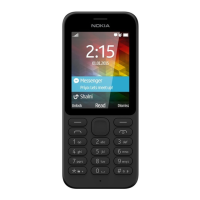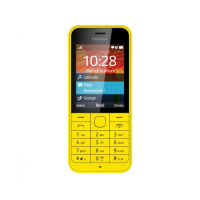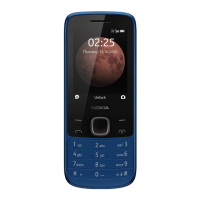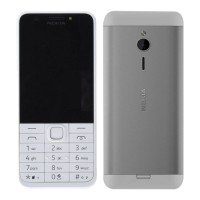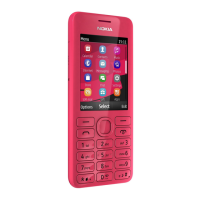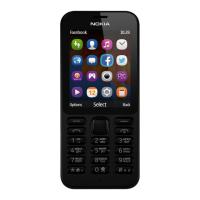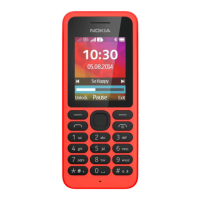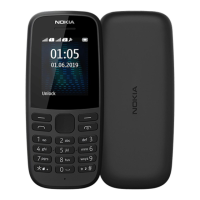
Do you have a question about the Nokia 210 Dual SIM and is the answer not in the manual?
| Panel type | LCD |
|---|---|
| Display diagonal | 2.4 \ |
| Display resolution | 320 x 240 pixels |
| Native aspect ratio | 4:3 |
| Display number of colors | 65536 colors |
| VoIP | Yes |
| Processor frequency | - GHz |
| RAM capacity | 0.03125 GB |
| Compatible memory cards | MicroSD (TransFlash) |
| Internal storage capacity | - GB |
| White balance | Auto, Daylight, Fluorescent |
| ISO sensitivity | Auto |
| Rear camera type | Single camera |
| Maximum frame rate | 10 fps |
| Optical sensor size | 1/5 \ |
| Rear camera resolution | 1600 x 1200 pixels |
| Video capture resolution (max) | 176 x 144 pixels |
| Rear camera resolution (numeric) | 2 MP |
| 2G standards | GPRS, GSM |
| SIM card type | MiniSIM |
| Wi-Fi standards | 802.11b, 802.11g |
| Bluetooth version | 2.1+EDR |
| Bluetooth profiles | HFP, HSP, OPP, PBAP, SDAP, SPP |
| SIM card capability | Dual SIM |
| Security algorithms | EAP-SIM, TKIP, WAPI, WEP, WPA, WPA2 |
| 2G bands (primary SIM) | 900, 1800 MHz |
| USB version | 2.0 |
| USB connector type | Micro-USB B |
| HDMI ports quantity | 0 |
| Headphone connectivity | 3.5 mm |
| Form factor | Bar |
| Product color | Black |
| Platform | Asha |
| Operating system installed | - |
| Personal info management (PIM) | Alarm clock, Calculator, Calendar, Converter, Detailed contact information, Dictionary, Games, Notes, Pedometer, Recorder, Stopwatch, To-do list |
| Voice codecs | AMR, AMR-NB |
| Audio formats supported | AMR, AMR-NB, MP3 |
| Image formats supported | BMP, EXIF, GIF, JPG, WEBP |
| Video formats supported | 3GP, ASF, AVC, H.263, H.264, M4V, MP4, MPEG4 |
| Video compression formats | 3GP, H.263 |
| Multimedia Messaging Service (MMS) | Multimedia Messaging Service (MMS) is a standard way to send messages that include multimedia content to and from a mobile phone over a cellular network |
| Keyboard layout | QWERTY |
| Battery type | BL-4U |
| Talk time (2G) | 12 h |
| Talk time (3G) | - h |
| Battery capacity | 1200 mAh |
| Standby time (2G) | 576 h |
| Browsing time (Wi-Fi) | 14 h |
| Continuous audio playback time | 40 h |
| Depth | 11.8 mm |
|---|---|
| Width | 60 mm |
| Height | 111.5 mm |
| Weight | 99.5 g |
Provides important safety and setup information for the device.
Instructions for manually setting the phone's time and date.
Details on setting and using the alarm clock feature.
Information on adding and managing calendar events.
Guide to using the phone's built-in calculator for calculations.
Identifies and describes the physical keys and components of the Nokia 210 phone.
Instructions for inserting SIM card, memory card, and battery, and switching on the phone.
Step-by-step guide to inserting SIM cards and memory card into the phone.
Instructions on how to power on the Nokia 210 device.
Guidance on recharging the phone's battery.
Detailed steps for charging the phone's battery using a wall outlet or USB.
Explanation of how to use the phone's keypad for navigation and input.
Instructions on typing text using the keypad, including character cases and numbers.
Instructions on making and answering phone calls.
Information on managing phone contacts and adding new entries.
Method to save numbers from the call history to contacts.
How to initiate a call directly from the saved contacts list.
Instructions for composing and sending text messages.
Guide to customizing ringtones and notification sounds for the device.
Instructions for changing the phone's wallpaper.
How to display the date and time on the home screen.
Introduction to phone profiles for different situations.
Details on customizing ringtones, volumes, and sounds for different profiles.
How to add quick access shortcuts to apps and settings on the home screen.
Steps to customize the 'Go to' shortcuts on the home screen.
Guidance on utilizing the dual SIM card functionality.
How to configure which SIM is used for calls and messages.
Introduction to the phone's camera capabilities for memories.
Instructions for capturing still images with the phone's camera.
How to adjust camera settings like brightness and effects.
Guide to recording video clips using the phone's camera.
Instructions for accessing and navigating the internet on the device.
Steps to establish an internet connection on the device.
Guide to connecting the phone to other devices via Bluetooth.
How to enable and manage Bluetooth connectivity.
Instructions for using the phone's music player to listen to MP3 files.
Steps to play MP3 music files on the device.
Guide to listening to the FM radio on the phone.
How to find and tune into FM radio stations.
Instructions for manually setting the phone's time and date.
How to configure a new alarm or modify existing ones.
Steps to add new appointments or reminders to the calendar.
Instructions for performing calculations using the phone's calculator.
How to delete personal data and content from the device.
Guide to resetting the phone to its original factory settings.
Essential safety guidelines for using the device safely.
When and where to switch off the device due to safety regulations.
Advice on safe driving practices while using the phone.
Information about potential interference from wireless devices.
Guidelines regarding authorized personnel for product repair.
Information on using approved batteries, chargers, and accessories.
Precautions to prevent water damage to the device.
Advice on preventing hearing damage from loud audio.
Information regarding Specific Absorption Rate (SAR) and RF exposure.
Instructions on making emergency calls and providing necessary information.
General advice for maintaining and protecting the device from damage.
Information on proper disposal and recycling of the device.
Explanation of the symbol for waste electrical and electronic equipment.
Safety information and best practices for batteries and chargers.
Safety warning about keeping the device away from small children.
Information on potential interference with medical devices.
Precautions for users with implanted medical devices.
Warning about potential hearing damage and interference with hearing aids.
Precautions to protect the device from viruses and malicious content.
Safety advice regarding device usage in vehicles.
When to switch off the device in potentially explosive areas.
Details on the device's compliance with RF exposure guidelines.
Information on obeying copyright laws and respecting digital rights.
Legal notices, disclaimers, and copyright information for the document.


